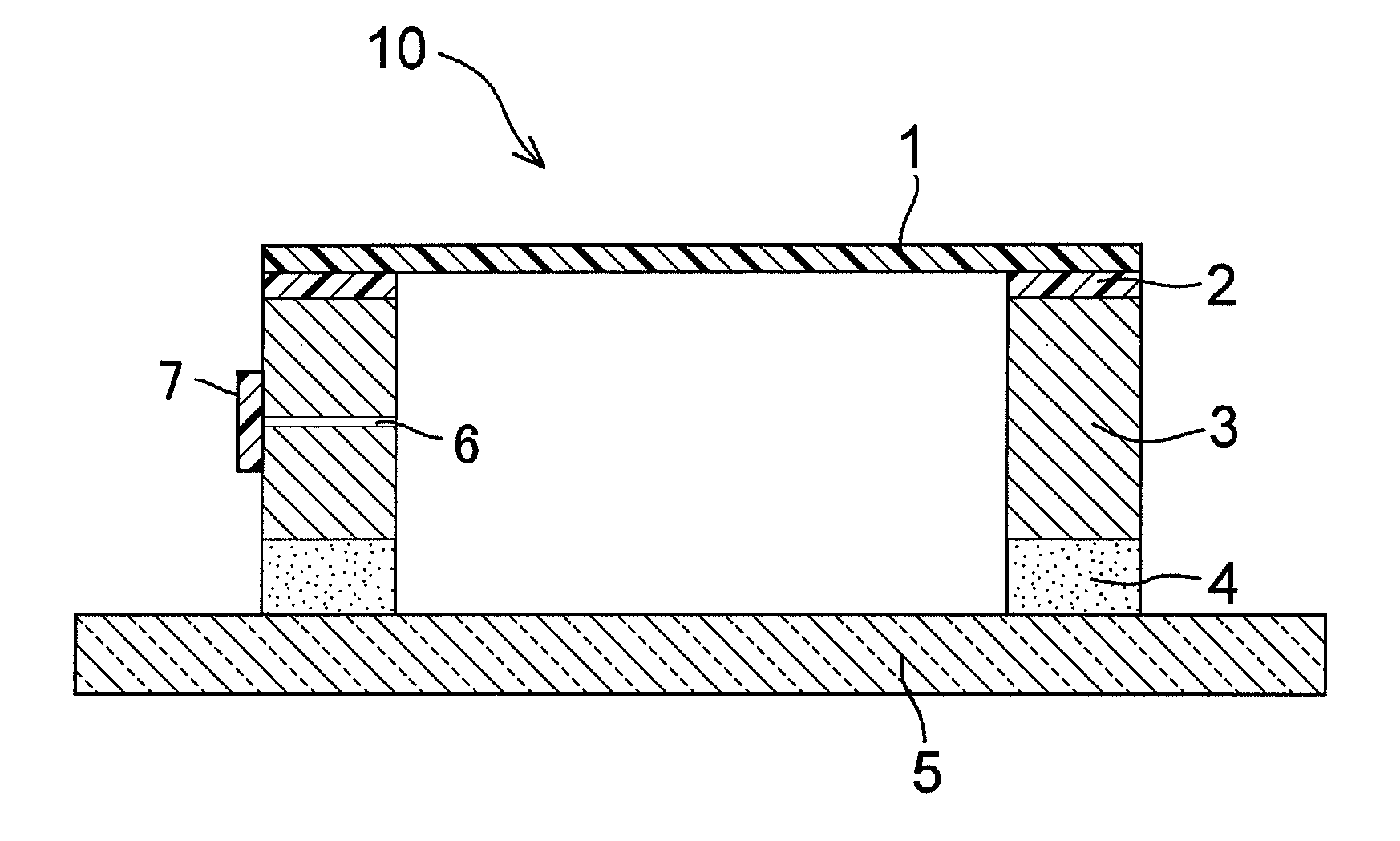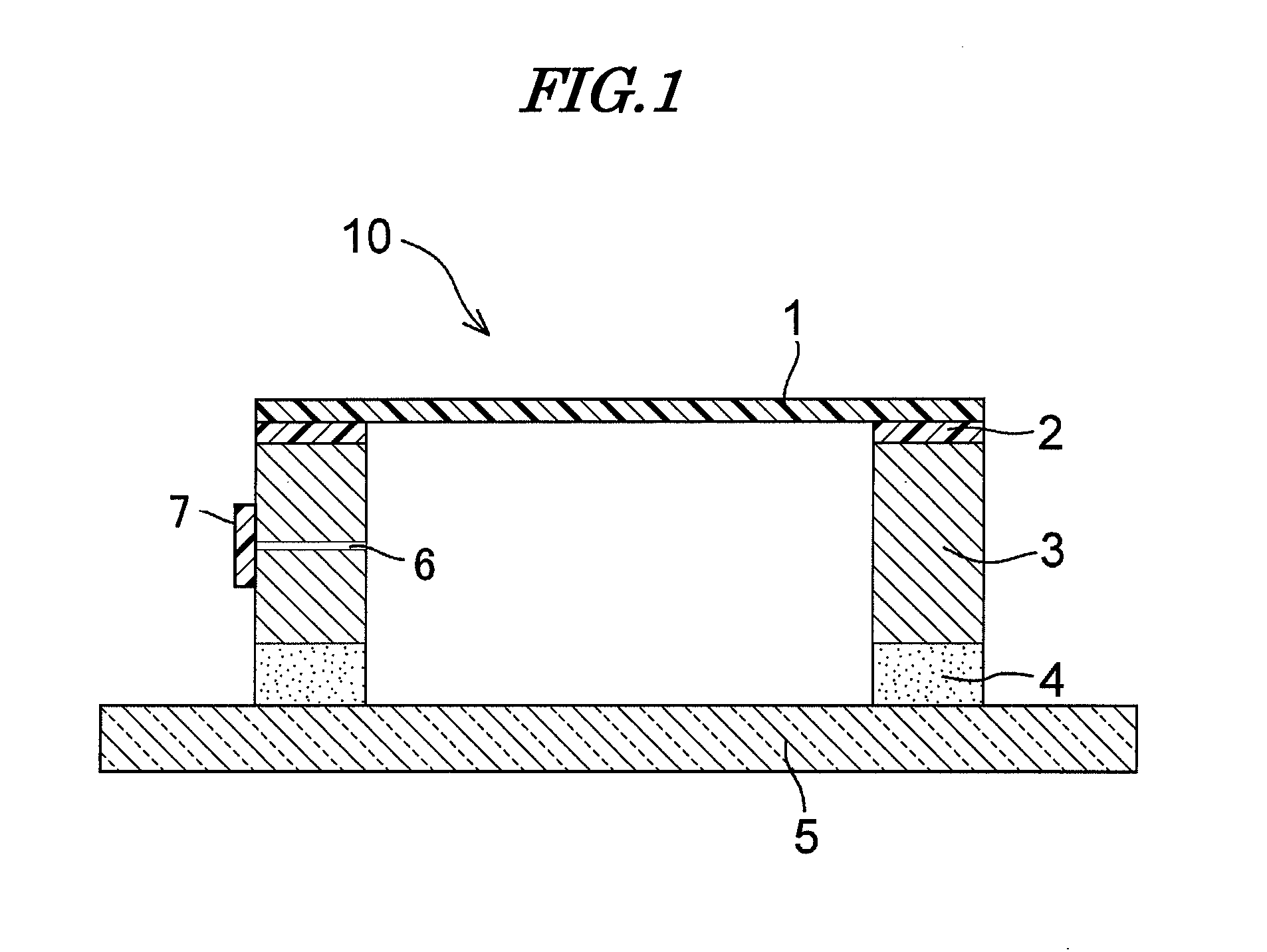Pellicle
a lithography and pellicle technology, applied in the field of lithography, can solve the problems of mask deformation, mask flatness can sometimes be degraded, defocusing within the exposure device, etc., and achieve the effect of suppressing the deformation of the exposure master pla
- Summary
- Abstract
- Description
- Claims
- Application Information
AI Technical Summary
Benefits of technology
Problems solved by technology
Method used
Image
Examples
example 1
[0040]An aluminum alloy pellicle frame (external dimensions 149 mm×113 mm×4.5 mm, thickness 2 mm, flatness on the pressure-sensitive adhesive layer side 30 μm) was washed with pure water, an end face thereof was coated with a silicone polymer gel (product name: KE-1051J) manufactured by Shin-Etsu Chemical Co., Ltd., and cured, thus forming a pressure-sensitive adhesion layer. Specifically, liquid A and liquid B of KE-1051J were mixed at a mixing ratio of 1:1 and placed in a syringe, coating was carried out using a dispenser, and subsequently curing was carried out at a curing temperature of 150° C. for a curing time of 10 min. The cured KE-1051J had a ¼ cone penetration in accordance with ASTM D-1403 of 65. The thickness of the cured KE-1051J was 0.3 mm.
[0041]Subsequently, the face of the pellicle frame opposite to the pressure-adhesive face was coated with a Cytop adhesive (product name: CTX-A) manufactured by Asahi Glass. Following this, the pellicle frame was heated at 130° C., t...
example 2
[0044]Pellicle 2 was completed in the same manner as in Example 1 except that the silicone polymer gel used in Example 1 was changed, and a silicone polymer gel (product name: X-32-1268) manufactured by Shin-Etsu Chemical Co., Ltd. was used.
[0045]The mixing ratio of liquid A and liquid B of X-32-1268 was 1:1, and curing conditions were a curing time of 10 min and a curing temperature of 150° C. The cured X-32-1268 had a ¼ cone penetration in accordance with ASTM D-1403 of 95. The thickness of the cured X-32-1268 was 0.3 mm.
[0046]When this pellicle 2 was affixed to a mask having a flatness of 0.20 μm, the flatness of the mask did not change and remained at 0.20 μm, this being very good result. The results thus obtained are shown in Table 1.
example 3
[0047]Pellicle 3 was completed in the same manner as in Examples 1 and 2 except that, unlike Examples 1 and 2, a urethane polymer gel (product name: Pandex GCA-11 / GCB-41) manufactured by DIC was used instead of the silicone polymer gel.
[0048]The mixing ratio of Pandex GCA-11 / GCB-41 was 100:12.5, and curing conditions were a curing time of 30 min and a curing temperature of 100° C. The cured Pandex GCA-11 / GCB-41 had a ¼ cone penetration in accordance with ASTM D-1403 of 55. The thickness of the cured Pandex GCA-11 / GCB-41 was 0.5 mm.
[0049]When this pellicle 3 was affixed to a mask having a flatness of 0.20 μm, the flatness of the mask changed to 0.22 μm. The amount of change in the flatness of the mask after affixing the pellicle was a low value of 0.02 μm, this being a good result. The results thus obtained are shown in Table 1.
PUM
| Property | Measurement | Unit |
|---|---|---|
| thickness | aaaaa | aaaaa |
| thickness | aaaaa | aaaaa |
| thickness | aaaaa | aaaaa |
Abstract
Description
Claims
Application Information
 Login to View More
Login to View More - R&D
- Intellectual Property
- Life Sciences
- Materials
- Tech Scout
- Unparalleled Data Quality
- Higher Quality Content
- 60% Fewer Hallucinations
Browse by: Latest US Patents, China's latest patents, Technical Efficacy Thesaurus, Application Domain, Technology Topic, Popular Technical Reports.
© 2025 PatSnap. All rights reserved.Legal|Privacy policy|Modern Slavery Act Transparency Statement|Sitemap|About US| Contact US: help@patsnap.com


